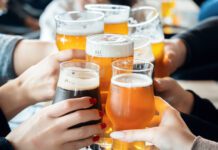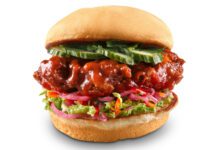There are a vast number of resources available for Canadian sushi and sashimi operators — or any foodservice operator who specializes in seafood — to help make informed and sustainable ingredient choices. Sustainable seafood has become a hot topic among diners as stories of over-fishing, product mis-labelling and the current climate crisis dominate news feeds.
SeaChoice is one of several Canadian-based ocean sustainability organizations that helps bring imperative research, guidelines and best practises to the Canadian public. We asked its seafood supply-chain analyst, Liane Veitch, more about the organization and how it can help foodservice providers make sustainable choices.
1. How does your organization help foodservice operators make sustainable decisions?
SeaChoice works throughout the seafood supply chain, and with fisheries and aquaculture managers and regulators, to increase the sustainability of seafood sold in Canada. One of our unique projects is called Seafood Progress, an online tool to assess and track changes in major Canadian food retailer’s seafood commitments and their performance against their commitments. While Seafood Progress doesn’t currently evaluate foodservice businesses, much of its framework is applicable and could be used by foodservice companies to see how their corporate policies compare. We also have lots of resources on our website to help seafood businesses make smart procurement and labelling decisions, including information on seafood products of particular concern (SeaChoice priority species) and on traceability tools.
2.How does SeaChoice work?
SeaChoice is a joint project of three environmental non-profit organizations: the David Suzuki Foundation, Ecology Action Centre and Living Ocean Society. Its mandate is carried out by experts at the three partner organizations and it is governed by a steering committee made up of one representative of each organization.
3. SeaChoice has done extensive research on Canadian seafood-labelling laws. What is the biggest issue with these current laws?
The biggest problem with Canadian seafood-labelling laws is that the bar is set so low. [Labels need to contain] only the common name of the species. If imported, the ‘place of last major transformation’ of the product, such as where it was canned or filleted (they call this ‘country of origin’, which it isn’t) also needs to be included. This means consumers don’t really know what they’re eating, where it came from or how it was produced. This could have potential health implications.. It makes it almost impossible to judge the environmental sustainability or social responsibility of the product and confuses people wanting to support Canadian fisheries and aquaculture.
The Canadian Food Inspection Agency (CFIA) has been working for the last six years on an initiative to modernize food labelling and we argued strongly that Canada should join the EU and the U.S., among other jurisdictions, in requiring more detailed labelling on seafood products. Unfortunately, CFIA’s proposed regulation basically maintains the status quo. That’s why SeaChoice is encouraging Canadian seafood businesses to voluntarily include more information on their seafood labels at point of sale, supported by robust traceability systems that ensure this key information is travelling up the supply chain.
4. Can you provide a few tips for purchasing sustainable seafood?
I get asked this all the time, but it’s a difficult. One good rule of thumb is to try and eat lower on the food chain — there are many more of these animals and they also tend to be healthier for you. But, since many stocks have different sustainability ratings, as do different farming methods, I recommend either looking for eco-certified products — such as those labelled ‘MSC’ or ‘ASC’ — or for products ranked Yellow/Green by Seafood Watch or Recommended by the Ocean Wise Seafood Program. You may need to ask for more information from your supplier about the provenance of the product, including whether it has any eco-certifications, in order to use these ranking tools.
5. There are so many seafood certifications, how can foodservice providers feel confident in those they purchase/support?
There are a lot of certifications out there, and they can really differ in what they include (for example vessel safety, environmental performance, social responsibility), how high their standards are and what traceability they require. It may require a little research to make sure the eco-certified products you’re buying are living up to their sustainability claims. SeaChoice has many resources about the various eco-certifications available in Canada, including a webinar explaining the main differences, advantages and disadvantages of the most prevalent eco-labels in the Canadian market.
6. What online resources could be useful to foodservice providers looking to make more sustainable seafood choices?
We have compiled a lot of useful resources on the SeaChoice webpage and there are also resources such as FishChoice.com, which allows members to search for suppliers who have products that meet their specifications and FisheryProgress.org — a database of fisheries engaged in improvement projects (this also reports on what progress they are actually making). You can also search directly for suppliers of certified products on MSC and ASC’s websites.




















